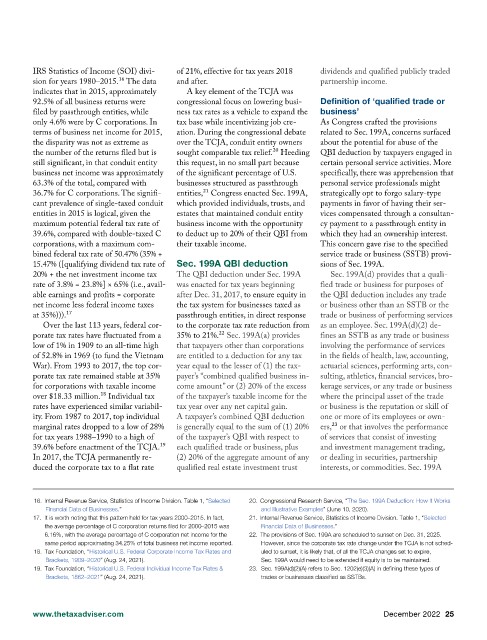Page 634 - TaxAdviser_2022
P. 634
IRS Statistics of Income (SOI) divi- of 21%, effective for tax years 2018 dividends and qualified publicly traded
sion for years 1980–2015.¹⁶ The data and after. partnership income.
indicates that in 2015, approximately A key element of the TCJA was
92.5% of all business returns were congressional focus on lowering busi- Definition of ‘qualified trade or
filed by passthrough entities, while ness tax rates as a vehicle to expand the business’
only 4.6% were by C corporations. In tax base while incentivizing job cre- As Congress crafted the provisions
terms of business net income for 2015, ation. During the congressional debate related to Sec. 199A, concerns surfaced
the disparity was not as extreme as over the TCJA, conduit entity owners about the potential for abuse of the
the number of the returns filed but is sought comparable tax relief.²⁰ Heeding QBI deduction by taxpayers engaged in
still significant, in that conduit entity this request, in no small part because certain personal service activities. More
business net income was approximately of the significant percentage of U.S. specifically, there was apprehension that
63.3% of the total, compared with businesses structured as passthrough personal service professionals might
36.7% for C corporations. The signifi- entities,²¹ Congress enacted Sec. 199A, strategically opt to forgo salary-type
cant prevalence of single-taxed conduit which provided individuals, trusts, and payments in favor of having their ser-
entities in 2015 is logical, given the estates that maintained conduit entity vices compensated through a consultan-
maximum potential federal tax rate of business income with the opportunity cy payment to a passthrough entity in
39.6%, compared with double-taxed C to deduct up to 20% of their QBI from which they had an ownership interest.
corporations, with a maximum com- their taxable income. This concern gave rise to the specified
bined federal tax rate of 50.47% (35% + service trade or business (SSTB) provi-
15.47% ([qualifying dividend tax rate of Sec. 199A QBI deduction sions of Sec. 199A.
20% + the net investment income tax The QBI deduction under Sec. 199A Sec. 199A(d) provides that a quali-
rate of 3.8% = 23.8%] × 65% (i.e., avail- was enacted for tax years beginning fied trade or business for purposes of
able earnings and profits = corporate after Dec. 31, 2017, to ensure equity in the QBI deduction includes any trade
net income less federal income taxes the tax system for businesses taxed as or business other than an SSTB or the
at 35%))).¹⁷ passthrough entities, in direct response trade or business of performing services
Over the last 113 years, federal cor- to the corporate tax rate reduction from as an employee. Sec. 199A(d)(2) de-
porate tax rates have fluctuated from a 35% to 21%.²² Sec. 199A(a) provides fines an SSTB as any trade or business
low of 1% in 1909 to an all-time high that taxpayers other than corporations involving the performance of services
of 52.8% in 1969 (to fund the Vietnam are entitled to a deduction for any tax in the fields of health, law, accounting,
War). From 1993 to 2017, the top cor- year equal to the lesser of (1) the tax- actuarial sciences, performing arts, con-
porate tax rate remained stable at 35% payer’s “combined qualified business in- sulting, athletics, financial services, bro-
for corporations with taxable income come amount” or (2) 20% of the excess kerage services, or any trade or business
over $18.33 million.¹⁸ Individual tax of the taxpayer’s taxable income for the where the principal asset of the trade
rates have experienced similar variabil- tax year over any net capital gain. or business is the reputation or skill of
ity. From 1987 to 2017, top individual A taxpayer’s combined QBI deduction one or more of its employees or own-
marginal rates dropped to a low of 28% is generally equal to the sum of (1) 20% ers,²³ or that involves the performance
for tax years 1988–1990 to a high of of the taxpayer’s QBI with respect to of services that consist of investing
39.6% before enactment of the TCJA.¹⁹ each qualified trade or business, plus and investment management trading,
In 2017, the TCJA permanently re- (2) 20% of the aggregate amount of any or dealing in securities, partnership
duced the corporate tax to a flat rate qualified real estate investment trust interests, or commodities. Sec. 199A
16. Internal Revenue Service, Statistics of Income Division. Table 1, “Selected 20. Congressional Research Service, “The Sec. 199A Deduction: How It Works
Financial Data of Businesses.” and Illustrative Examples” (June 10, 2020).
17. It is worth noting that this pattern held for tax years 2000–2015. In fact, 21. Internal Revenue Service, Statistics of Income Division. Table 1, “Selected
the average percentage of C corporation returns filed for 2000–2015 was Financial Data of Businesses.”
6.16%, with the average percentage of C corporation net income for the 22. The provisions of Sec. 199A are scheduled to sunset on Dec. 31, 2025.
same period approximating 34.25% of total business net income reported. However, since the corporate tax rate change under the TCJA is not sched-
18. Tax Foundation, “Historical U.S. Federal Corporate Income Tax Rates and uled to sunset, it is likely that, of all the TCJA changes set to expire,
Brackets, 1909–2020” (Aug. 24, 2021). Sec. 199A would need to be extended if equity is to be maintained.
1 9. Tax Foundation, “Historical U.S. Federal Individual Income Tax Rates & 23. Sec. 199A(d)(2)(A) refers to Sec. 1202(e)(3)(A) in defining these types of
Brackets, 1862–2021” (Aug. 24, 2021). trades or businesses classified as SSTBs.
www.thetaxadviser.com December 2022 25

